外研版七年级英语上册Module 4 Healthy food Unit 3 Language in use.课件 (共49张PPT)
文档属性
| 名称 | 外研版七年级英语上册Module 4 Healthy food Unit 3 Language in use.课件 (共49张PPT) | 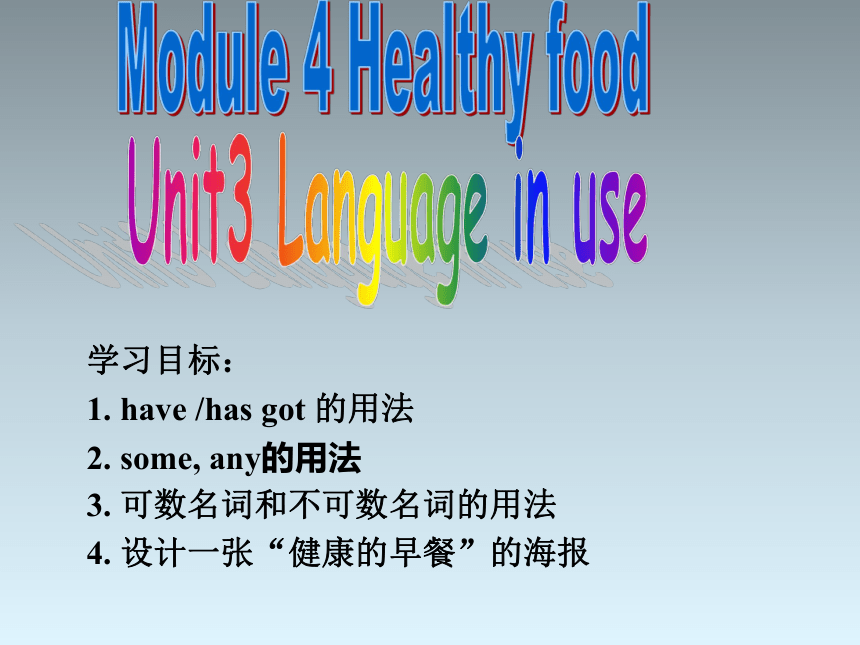 | |
| 格式 | ppt | ||
| 文件大小 | 5.7MB | ||
| 资源类型 | 教案 | ||
| 版本资源 | 外研版 | ||
| 科目 | 英语 | ||
| 更新时间 | 2022-07-26 12:40:30 | ||
图片预览

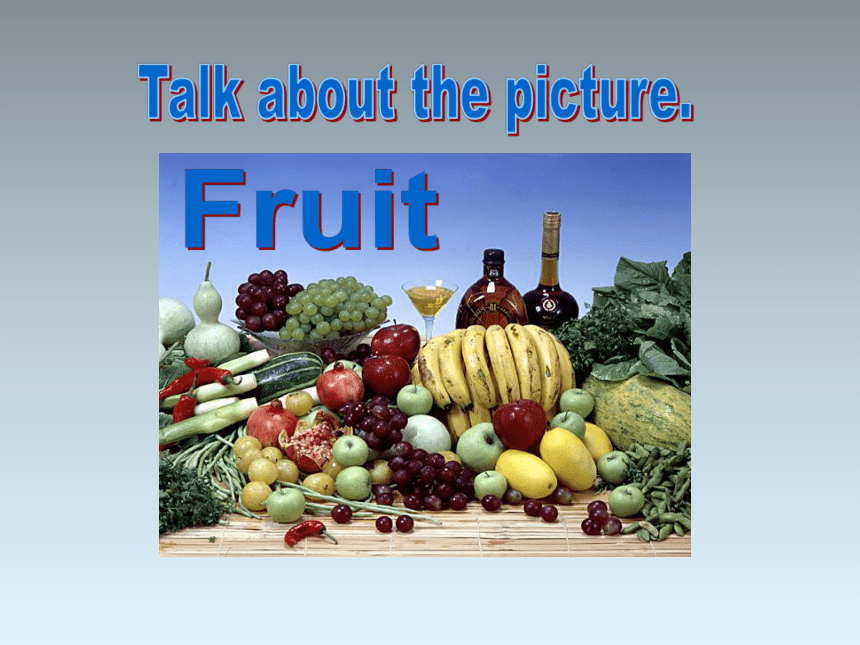
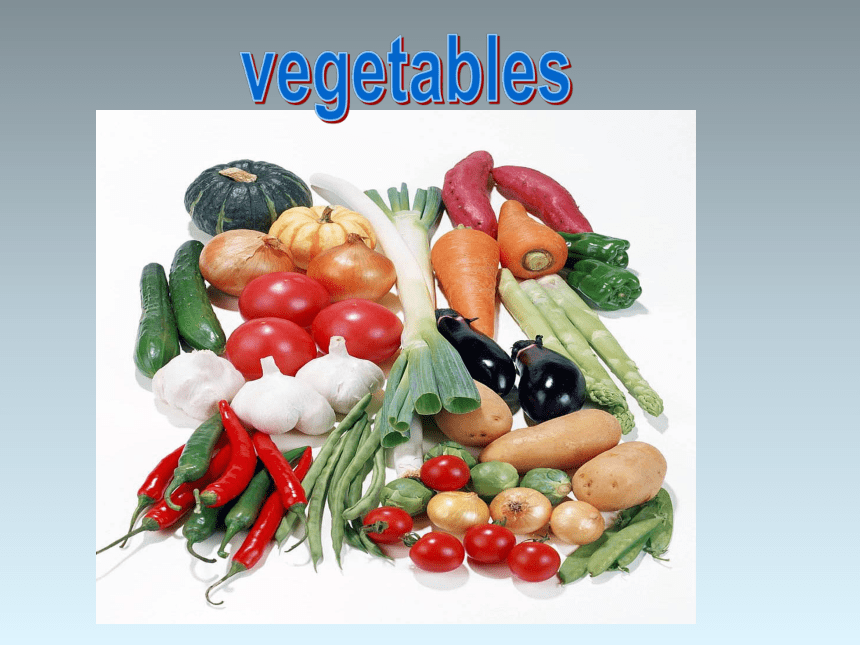
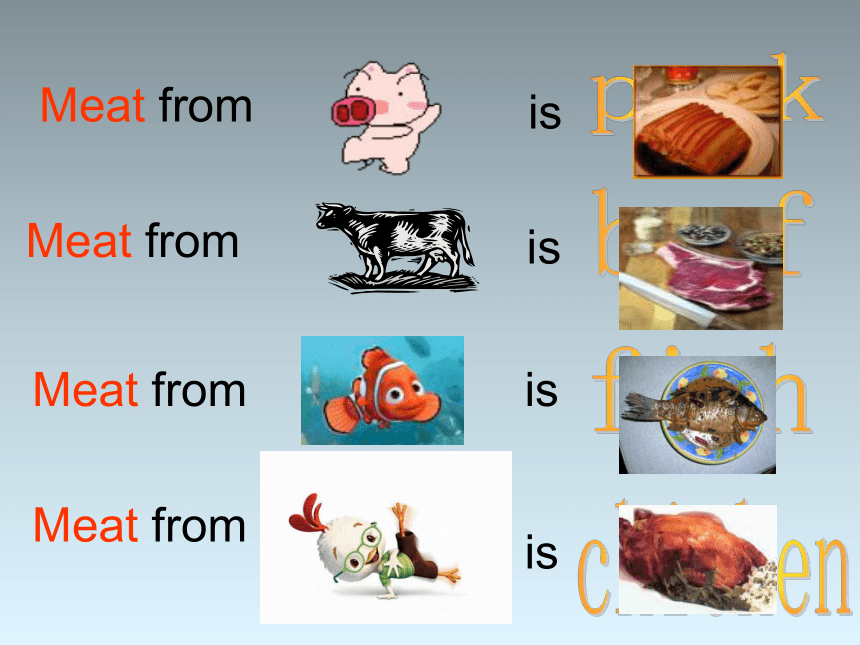
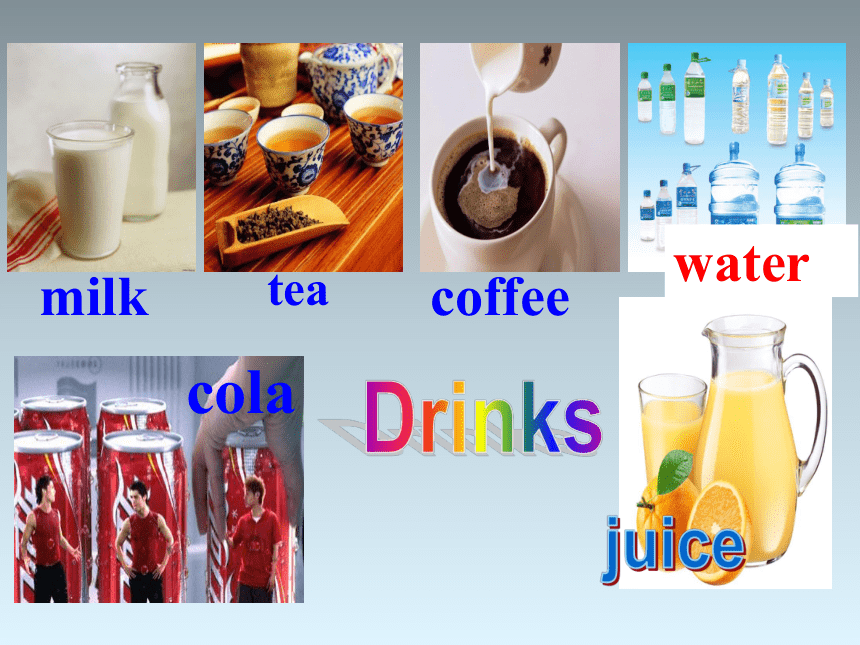

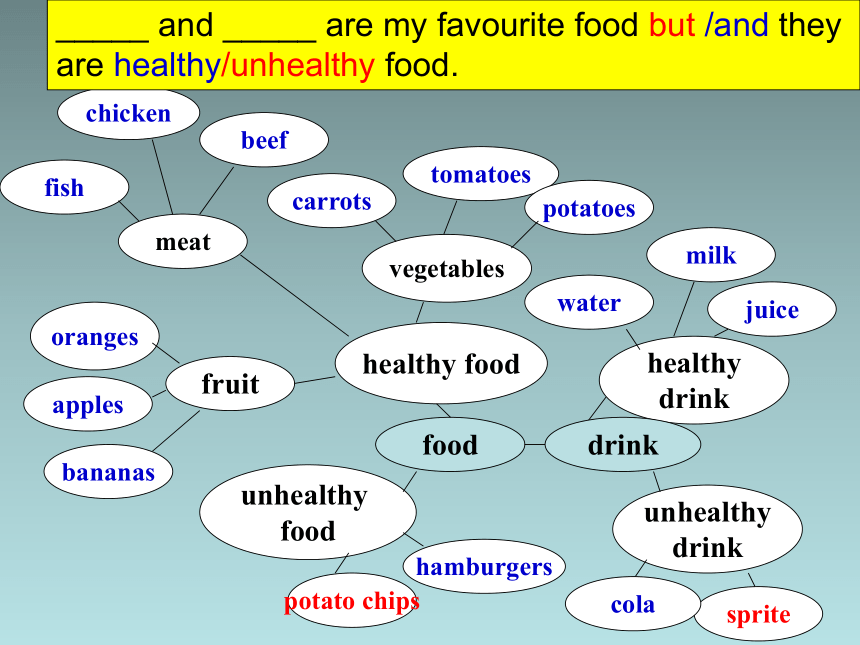
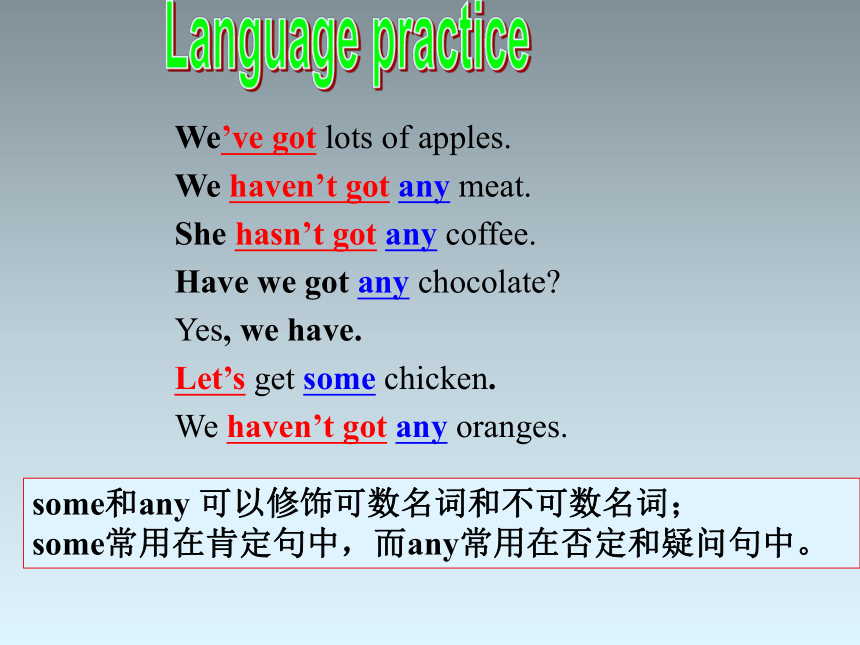

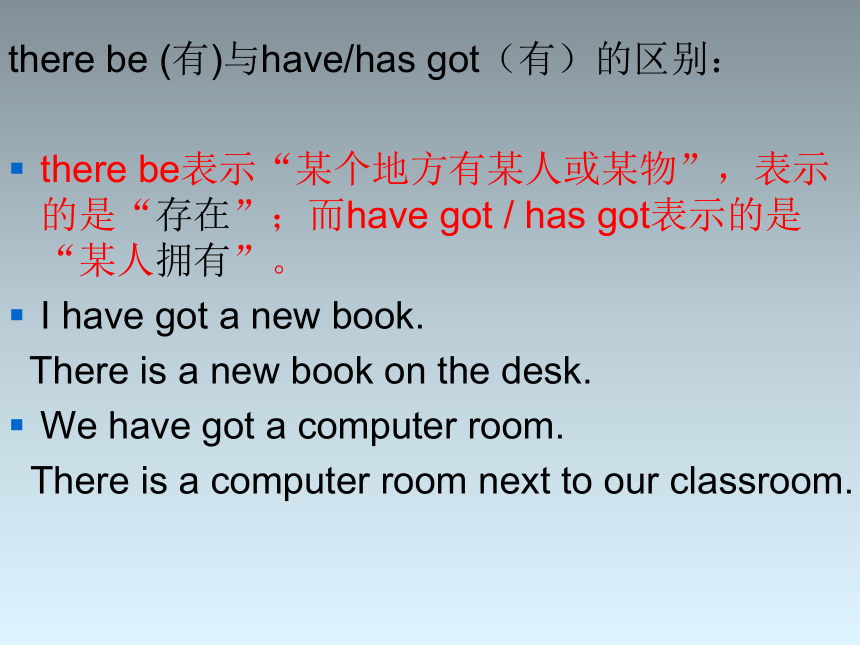


文档简介
(共49张PPT)
学习目标:
1. have /has got 的用法
2. some, any的用法
3. 可数名词和不可数名词的用法
4. 设计一张“健康的早餐”的海报
Meat from
Meat from
is
is
Meat from
is
Meat from
is
milk
tea
coffee
water
cola
Complete the word map
healthy food
fruit
meat
vegetables
favourite food
food
drink
healthy drink
favourite drink
unhealthy drink
unhealthy food
carrots
tomatoes
vegetables
bananas
apples
oranges
fruit
healthy food
hamburgers
potato chips
unhealthy
food
food
juice
milk
water
healthy
drink
unhealthy
drink
sprite
beef
chicken
fish
meat
potatoes
drink
cola
_____ and _____ are my favourite food but /and they are healthy/unhealthy food.
We’ve got lots of apples.
We haven’t got any meat.
She hasn’t got any coffee.
Have we got any chocolate
Yes, we have.
Let’s get some chicken.
We haven’t got any oranges.
some和any 可以修饰可数名词和不可数名词; some常用在肯定句中,而any常用在否定和疑问句中。
一、have got /has got的用法
have got /has got 有
肯定句:I/We/You/They have got … .
He/She/It has got … .
否定句: I/We/You/They haven’t got … .
He/She/It hasn’t got … .
一般疑问句: Have I/we/you/they got …
肯定回答:Yes, I/we/you/they have.
否定回答:No, I/we/you/they haven’t.
一般疑问句: Has he/she/it got …
肯定回答: Yes, he/she/it has.
No, he/she/it hasn’t.
there be (有)与have/has got(有)的区别:
there be表示“某个地方有某人或某物”,表示的是“存在”;而have got / has got表示的是“某人拥有”。
I have got a new book.
There is a new book on the desk.
We have got a computer room.
There is a computer room next to our classroom.
— Have we got any…
—Yes, we have.
/ No, we haven’t.
e.g.:
— Have we got any
meat in the fridge
— Yes, we have.
Work in pairs.
1. _______________ vegetables.
2. ________________ oranges.
3. ________________ apples.
4. ________________ eggs.
5. ________________ bananas.
6. _______________orange juice.
7. ________________ milk.
We’ve got some meat.
We haven’t got any fish.
1. We’ve got some vegetables.
2. We haven’t got any oranges.
3. We haven’t got any apples.
4. We’ve got some eggs.
5. We’ve got some bananas.
6. We’ve got some orange juice.
7. We haven’t got any milk.
countable nouns
(可数名词)
uncountable nouns
(不可数名词)
some/any
Now write about the food in the fridge.
A2 Look at the picture and talk about it.
apple hamburger orange potato tomato
apples hamburgers oranges potatoes tomatoes
fish meat rice milk juice chicken water
He has got some a(n)…
He hasn’t got any…
She has got some a(n)…
She hasn’t got any…
The have got some a(n)…
They haven’t got any…
He has got some/a/an _________________.
He hasn’t got any ______________________
She has got some /a /an_________________
She hasn’t got any_____________________
They have got some/a/an_________________
They haven’t got any___________________
2. Look at the picture and talk about it.
chicken/fish/meat/rice/potatoes
/water
juice/oranges/apples/milk/hamburgers.
juice/oranges/apples/milk/
a hamburger.
chicken/fish/meat/rice/potatoes
noodles
food and drinks.
noodles.
可数名词:
(1)定义:是可以计数的名词
(2)可数名词前可以用a, an限定,表示一个……
(3)可数名词前可以用one, two, three…限定。
(4)可数名词有复数形式。
一、可数名词和不可数名词的区别
Grammar
可数名词:
(1)定义:是可以计数的名词
(2)可数名词前可以用a, an限定,表示一个……
(3)可数名词前可以用one, two, three…限定。
(4)可数名词有复数形式。
A) 构成方法及读音规则
1) 一般情况加 –s:map-maps boy-boys girl-girls pen-pens bag-bags car-cars
清辅音后读 浊辅音和元音后读
2) 以s, sh, ch, x等结尾加 –es,如:
bus-buses watch-watches box-boxes brush-brushes
可数名词复数形式变化
3) 以辅音字母+y结尾, 变 y 为 i 再加 es, 如:baby---babies
city-cities
country-countries
但以y结尾的专有名词,或元音字母+y 结尾的名词变复数时,直接加s变复数。
如:
monkey---monkeys
holiday---holidays
4) 以o结尾的名词,变复数时:
A. 加s, 如: photo— photos
piano—pianos
radio—radios
zoo—zoos;
B. 加es, 如: potato— potatoes
tomato—tomatoes
5) 以 f 或 fe 结尾的名词变复数时:
改 f, fe 为v再加 -es,
如:half—halves knife—knives
leaf--leaves wolf—wolves
wife—wives life—lives
Notes: 由一个词加 man 或 woman构成的合成词, 其复数形式也是 -men 和-women, 如an Englishman, two Englishmen。但German不是合成词, 故复数形式为Germans;Bowman是姓,其复数是the Bowmans。
B)名词复数的不规则变化
child—children, foot—feet,
tooth—teeth, mouse—mice,
man—-men, woman—women
2) 单复同形, 如deer, sheep, fish, Chinese, Japanese, 等。但除人民币的元、角、分外, 美元、英镑、法郎等都有复数形式。如:a dollar, two dollars; a meter, two meters。
3) 集体名词, 以单数形式出现, 但实为复数。例如:people, police 等本身就是复数,只能说 many people/police, 但可以说a person, a policeman.
4)以s结尾,仍为单数的名词,如:
a. maths, politics, physics等学科名词,一般是不可数名词,为单数。
b. news 为不可数名词。
c. the United States, the United Nations 应视为单数。
The United Nations was organized in 1945. 联合国是1945年组建起来的。
d. 以复数形式出现的书名,剧名,报纸,杂志名,也可视为单数。
5) 表示由两部分构成的东西,如:glasses (眼镜)trousers, clothes等,若表达具体数目,要借助数量词 pair(对,双); suit(套); 如: a pair of glasses, 一副眼镜;two pairs of trousers,一条裤子等。
6) 另外还有一些名词,其复数形式有时可表示特别意思,如:goods 货物,waters 水域,fishes(各种)鱼。
不可数名词
(1)定义:是指不能计数的名词。
(2)不可数名词前不可以用a , an限定。
(3)不可数名词前不可以用one, two, three…
限定。
(4)不可数名词没有复数形式。
不可数名词主要分为
物质名词和抽象名词。
1) 物质名词是指表示无法分为个体的实物的词, 常见的物质名词, 如:snow(雪), rain(雨), water(水), coffee(咖啡), tea(茶), meat (肉), milk(牛奶), rice(米饭), bread(面包), orange (桔汁), beef (牛肉), chicken(鸡肉), juice (果汁), pork(猪肉), Coke (可口可乐), ice cream (冰激凌) 等;
2) 抽象名词是指表示动作、状态、品质、感情等抽象概念的词,常见的抽象名词,如:work(工作), study(学习), love(爱), friendship (友谊)等。
A.写出下列名词的复数形式
1. apple – apples 2. orange – oranges
3. potato – potatoes 4. carrot – carrots
5. banana – bananas 6. egg – eggs
7. hamburger – hamburgers
8. noodle – noodles 9. onion – onions
10. vegetable – vegetables
11. tomato – tomatoes 12. melon – melons
二、可数名词和不可数名词的用法
(一)、可数名词有单数、复数之分,如:
map → maps
不可数名词没有复数形式,只有单数形式。如:
some water
(二)、单数可数名词表示泛指时,前面要用不定冠词 a (an) ;而不可数名词不能用 a (an) .
如:Li Hong is a driver. I am a teacher. 李红是一名司机,我是一名教师。
We can't see milk on the table. 我们看不见桌上有牛奶。
[ 友情提醒 ] 在表示特指时,不可数名词和可数名词
前都要用定冠词 the .如:
Pass me the ball, please. 请把球传给我。
(三)、可数名词表示复数意义时可用 many 等词修饰。如:
many apples a lot of tomatoes a few pens
不可数名词则要用 much 、 a little 等词修饰。如:
much meat, a little bread,little water
[ 友情提醒 ] 这两类名词都可以被 some 、 any 、 a lot of (lost of) 等修饰。如: some eggs/ paper (纸),a lot of (lots of) knives / orange juice
some ,any的用法
1)、some“一些”,用于肯定句中,any “一些”用于否定句和疑问句中。
some和any既可以用于可数名词的复数之前,也可以用于不可数名词之前,可数名词如果是单数,加不定冠词,而不可数名词只要表示一定的量就要加some或any。如:There is some rice in the bowl.碗里有一些米饭。
2)、Some用在可数名词之前,可数名词就要用复数形式。
(四)、可数名词前通常可用具体的数词来修饰。如:
three women
ten babies
不可数名词表示数量的多少时,必须与表示数量的名词连用,即“数词 + 表示数量的名词(可数名词) + of + 不可数名词”。如:
two glasses of milk 两杯牛奶
five pieces of bread 五片面包
(五)、 How many/ How much的用法
对可数名词的数量提问用 how many ;对不可数名词的数量提问要用 how much ,但对不可数名词前表示数量名词中的修饰语提问时要用 how many .
How many +名词复数+are there+----
There are+基数词+(名词复数).
如: How many people are there in your family There are three people in my family.
How much +不可数名词+is there+----
There is +some /a little+不可数名词+-----.
如:How much water is there in the glass
There is a little water in the glass.
How much还可提问价钱。
如: How much is the pen
How much are the books
(六)、可数名词作主语时,谓语动词的单、复数与主语的单、复数须保持一致。不可数名词作主语时,谓语动词只能用单数形式。如:
There is some rice in the bowl. 碗里有些米饭。
All the students are in the classroom. 所有的学生都在教室里。
[ 友情提醒 ] 如果不可数名词前有复数名词短语修饰时,谓语动词须用复数形式。如:
There are two bags of rice in the room. 房间里有两袋子大米。
不可数名词作语时,谓语主动词用单数如:Coke isn’t a healthy drink.
如果有两个或两个以上的不可数名词作主语时并用and连接,则表示复数意义,谓语动词用复数,如:Meat and fish are healthy food.
用and连接两个并列的名词,谓语动词用复数
but是转折连词,意为 “但是,然而”表转折意义。
Complete the sentences with the correct form of the words from the box
1.___________to buy some fruit.
2.It’s___________to eat healthy food.
3.Eat well and _______healthy.
4.Orange juice is ________.Let’s buy some.
5.I am a ______ tired.
bit delicious important remember stay
Remember
important
stay
delicious
bit
In the West, for breakfast, people usually eat bread and eggs and drink coffee or tea, milk and fruit juice.
Interview: Do you have a healthy breakfast
student A: a reporter from CNTV, student B: yourself
A: Hello! What do you usually have for breakfast
B: I usually have … and … for breakfast.
A: Is your breakfast healthy
B: Yes, … is/are healthy and it’s /they’re good for me.
No, … isn’t/aren’t good for me but it’s/they’re delicious.
A: Thank you. It’s important to remember: eat well and stay healthy.
B: All right.
eggs, cakes, pancakes, noodles, apples
milk, bread, porridge,---
For breakfast, I like … , because … is / are good for my … .
II. The food you like for breakfast
A healthy breakfast
It is very important to have a healthy breakfast. For breakfast ,We have cakes and milk. Milk is good for our teeth. we eat an apple, too and it’s delicious. A bit tired, we have eggs!
Remember: eat a healthy breakfast and stay healthy!
What do they usually have for breakfast
Is the breakfast healthy Why do you think so
A healthy breakfast
In our group, we’ve got some _____________. For breakfast , We eat ____ and it’s/they're ___. We eat some ____,too and it’s/they're ____.
Remember: eat a healthy breakfast and stay healthy!
Imitate (模仿) the posters and write about your poster about a healthy breakfast.
A healthy breakfast
Homework
Polish your poster about a healthy breakfast
Exercises
A. 用 some, any填空。
1. Have you got ____ fruit
Yes, we have.
2. Have we got ___ meat
No, we haven’t.
3. We’ve got _____ oranges and ____ apples.
4. We have got _____ melons.
5. We haven’t got ____ tomatoes.
any
any
any
some
some
some
B. 用 所给名词的适当形式填空。
1. I have ____ (bread) and _____ (milk) for breakfast.
2. Meat, ________(vegetable) and fruit are healthy food.
3. We haven’t got any_______ (potato) or ____ (tomato) .
4. Many children like to eat ___________ ( hamburger).
But they’re not good for health.
5. ---Have you got any ______ (meat)
---Yes, we have.
bread
milk
vegetables
potatoes
tomatoes
hamburgers
meat
C. 完成句子:
1. 我们有一些牛肉吗? 没有。
______ we _____________
No, __________.
2. 你们有一些土豆吗? 有。
_____ you________________
Yes, _______.
3. 我们的冰箱里没有胡萝卜。
We ____________________ in the fridge.
Have got any beef
we have
Have got any potatoes
we haven’t
haven’t got any carrots
4. 鱼和蔬菜是健康的食品,但汉堡包不是。
Fish and vegetables ________________,
______________________ healthy food.
5. 吃些水果,不要吃糖果和冰激淋。
___ some fruit, ___ candies __ ice cream.
are healthy food
but hamburgers aren’t
Eat not or
My name is Tom. I’m from A _______ I’m fourteen y ____ old. I’m in China with my p _______ now. I like China. I like C _____ food, too. I eat rice and v _________ everyday. They are h ______ food. My favourite vegetables are carrots and t________. I like drinking tea. My father and mother like d _______ tea, too. I don’t like coke. Coke is u _______ drink. I eat noodles, fish and meat, too. I don’t like candy. Candy isn’t healthy food. I like fruit. Apples are my favourite f _____.
merica
ears
arents
hinese
egetables
ealthy
D.根据首字母提示,在空格处填入正确的词,使短文意思完整。
omatoes
rinking
nhealthy
ruit
学习目标:
1. have /has got 的用法
2. some, any的用法
3. 可数名词和不可数名词的用法
4. 设计一张“健康的早餐”的海报
Meat from
Meat from
is
is
Meat from
is
Meat from
is
milk
tea
coffee
water
cola
Complete the word map
healthy food
fruit
meat
vegetables
favourite food
food
drink
healthy drink
favourite drink
unhealthy drink
unhealthy food
carrots
tomatoes
vegetables
bananas
apples
oranges
fruit
healthy food
hamburgers
potato chips
unhealthy
food
food
juice
milk
water
healthy
drink
unhealthy
drink
sprite
beef
chicken
fish
meat
potatoes
drink
cola
_____ and _____ are my favourite food but /and they are healthy/unhealthy food.
We’ve got lots of apples.
We haven’t got any meat.
She hasn’t got any coffee.
Have we got any chocolate
Yes, we have.
Let’s get some chicken.
We haven’t got any oranges.
some和any 可以修饰可数名词和不可数名词; some常用在肯定句中,而any常用在否定和疑问句中。
一、have got /has got的用法
have got /has got 有
肯定句:I/We/You/They have got … .
He/She/It has got … .
否定句: I/We/You/They haven’t got … .
He/She/It hasn’t got … .
一般疑问句: Have I/we/you/they got …
肯定回答:Yes, I/we/you/they have.
否定回答:No, I/we/you/they haven’t.
一般疑问句: Has he/she/it got …
肯定回答: Yes, he/she/it has.
No, he/she/it hasn’t.
there be (有)与have/has got(有)的区别:
there be表示“某个地方有某人或某物”,表示的是“存在”;而have got / has got表示的是“某人拥有”。
I have got a new book.
There is a new book on the desk.
We have got a computer room.
There is a computer room next to our classroom.
— Have we got any…
—Yes, we have.
/ No, we haven’t.
e.g.:
— Have we got any
meat in the fridge
— Yes, we have.
Work in pairs.
1. _______________ vegetables.
2. ________________ oranges.
3. ________________ apples.
4. ________________ eggs.
5. ________________ bananas.
6. _______________orange juice.
7. ________________ milk.
We’ve got some meat.
We haven’t got any fish.
1. We’ve got some vegetables.
2. We haven’t got any oranges.
3. We haven’t got any apples.
4. We’ve got some eggs.
5. We’ve got some bananas.
6. We’ve got some orange juice.
7. We haven’t got any milk.
countable nouns
(可数名词)
uncountable nouns
(不可数名词)
some/any
Now write about the food in the fridge.
A2 Look at the picture and talk about it.
apple hamburger orange potato tomato
apples hamburgers oranges potatoes tomatoes
fish meat rice milk juice chicken water
He has got some a(n)…
He hasn’t got any…
She has got some a(n)…
She hasn’t got any…
The have got some a(n)…
They haven’t got any…
He has got some/a/an _________________.
He hasn’t got any ______________________
She has got some /a /an_________________
She hasn’t got any_____________________
They have got some/a/an_________________
They haven’t got any___________________
2. Look at the picture and talk about it.
chicken/fish/meat/rice/potatoes
/water
juice/oranges/apples/milk/hamburgers.
juice/oranges/apples/milk/
a hamburger.
chicken/fish/meat/rice/potatoes
noodles
food and drinks.
noodles.
可数名词:
(1)定义:是可以计数的名词
(2)可数名词前可以用a, an限定,表示一个……
(3)可数名词前可以用one, two, three…限定。
(4)可数名词有复数形式。
一、可数名词和不可数名词的区别
Grammar
可数名词:
(1)定义:是可以计数的名词
(2)可数名词前可以用a, an限定,表示一个……
(3)可数名词前可以用one, two, three…限定。
(4)可数名词有复数形式。
A) 构成方法及读音规则
1) 一般情况加 –s:map-maps boy-boys girl-girls pen-pens bag-bags car-cars
清辅音后读 浊辅音和元音后读
2) 以s, sh, ch, x等结尾加 –es,如:
bus-buses watch-watches box-boxes brush-brushes
可数名词复数形式变化
3) 以辅音字母+y结尾, 变 y 为 i 再加 es, 如:baby---babies
city-cities
country-countries
但以y结尾的专有名词,或元音字母+y 结尾的名词变复数时,直接加s变复数。
如:
monkey---monkeys
holiday---holidays
4) 以o结尾的名词,变复数时:
A. 加s, 如: photo— photos
piano—pianos
radio—radios
zoo—zoos;
B. 加es, 如: potato— potatoes
tomato—tomatoes
5) 以 f 或 fe 结尾的名词变复数时:
改 f, fe 为v再加 -es,
如:half—halves knife—knives
leaf--leaves wolf—wolves
wife—wives life—lives
Notes: 由一个词加 man 或 woman构成的合成词, 其复数形式也是 -men 和-women, 如an Englishman, two Englishmen。但German不是合成词, 故复数形式为Germans;Bowman是姓,其复数是the Bowmans。
B)名词复数的不规则变化
child—children, foot—feet,
tooth—teeth, mouse—mice,
man—-men, woman—women
2) 单复同形, 如deer, sheep, fish, Chinese, Japanese, 等。但除人民币的元、角、分外, 美元、英镑、法郎等都有复数形式。如:a dollar, two dollars; a meter, two meters。
3) 集体名词, 以单数形式出现, 但实为复数。例如:people, police 等本身就是复数,只能说 many people/police, 但可以说a person, a policeman.
4)以s结尾,仍为单数的名词,如:
a. maths, politics, physics等学科名词,一般是不可数名词,为单数。
b. news 为不可数名词。
c. the United States, the United Nations 应视为单数。
The United Nations was organized in 1945. 联合国是1945年组建起来的。
d. 以复数形式出现的书名,剧名,报纸,杂志名,也可视为单数。
5) 表示由两部分构成的东西,如:glasses (眼镜)trousers, clothes等,若表达具体数目,要借助数量词 pair(对,双); suit(套); 如: a pair of glasses, 一副眼镜;two pairs of trousers,一条裤子等。
6) 另外还有一些名词,其复数形式有时可表示特别意思,如:goods 货物,waters 水域,fishes(各种)鱼。
不可数名词
(1)定义:是指不能计数的名词。
(2)不可数名词前不可以用a , an限定。
(3)不可数名词前不可以用one, two, three…
限定。
(4)不可数名词没有复数形式。
不可数名词主要分为
物质名词和抽象名词。
1) 物质名词是指表示无法分为个体的实物的词, 常见的物质名词, 如:snow(雪), rain(雨), water(水), coffee(咖啡), tea(茶), meat (肉), milk(牛奶), rice(米饭), bread(面包), orange (桔汁), beef (牛肉), chicken(鸡肉), juice (果汁), pork(猪肉), Coke (可口可乐), ice cream (冰激凌) 等;
2) 抽象名词是指表示动作、状态、品质、感情等抽象概念的词,常见的抽象名词,如:work(工作), study(学习), love(爱), friendship (友谊)等。
A.写出下列名词的复数形式
1. apple – apples 2. orange – oranges
3. potato – potatoes 4. carrot – carrots
5. banana – bananas 6. egg – eggs
7. hamburger – hamburgers
8. noodle – noodles 9. onion – onions
10. vegetable – vegetables
11. tomato – tomatoes 12. melon – melons
二、可数名词和不可数名词的用法
(一)、可数名词有单数、复数之分,如:
map → maps
不可数名词没有复数形式,只有单数形式。如:
some water
(二)、单数可数名词表示泛指时,前面要用不定冠词 a (an) ;而不可数名词不能用 a (an) .
如:Li Hong is a driver. I am a teacher. 李红是一名司机,我是一名教师。
We can't see milk on the table. 我们看不见桌上有牛奶。
[ 友情提醒 ] 在表示特指时,不可数名词和可数名词
前都要用定冠词 the .如:
Pass me the ball, please. 请把球传给我。
(三)、可数名词表示复数意义时可用 many 等词修饰。如:
many apples a lot of tomatoes a few pens
不可数名词则要用 much 、 a little 等词修饰。如:
much meat, a little bread,little water
[ 友情提醒 ] 这两类名词都可以被 some 、 any 、 a lot of (lost of) 等修饰。如: some eggs/ paper (纸),a lot of (lots of) knives / orange juice
some ,any的用法
1)、some“一些”,用于肯定句中,any “一些”用于否定句和疑问句中。
some和any既可以用于可数名词的复数之前,也可以用于不可数名词之前,可数名词如果是单数,加不定冠词,而不可数名词只要表示一定的量就要加some或any。如:There is some rice in the bowl.碗里有一些米饭。
2)、Some用在可数名词之前,可数名词就要用复数形式。
(四)、可数名词前通常可用具体的数词来修饰。如:
three women
ten babies
不可数名词表示数量的多少时,必须与表示数量的名词连用,即“数词 + 表示数量的名词(可数名词) + of + 不可数名词”。如:
two glasses of milk 两杯牛奶
five pieces of bread 五片面包
(五)、 How many/ How much的用法
对可数名词的数量提问用 how many ;对不可数名词的数量提问要用 how much ,但对不可数名词前表示数量名词中的修饰语提问时要用 how many .
How many +名词复数+are there+----
There are+基数词+(名词复数).
如: How many people are there in your family There are three people in my family.
How much +不可数名词+is there+----
There is +some /a little+不可数名词+-----.
如:How much water is there in the glass
There is a little water in the glass.
How much还可提问价钱。
如: How much is the pen
How much are the books
(六)、可数名词作主语时,谓语动词的单、复数与主语的单、复数须保持一致。不可数名词作主语时,谓语动词只能用单数形式。如:
There is some rice in the bowl. 碗里有些米饭。
All the students are in the classroom. 所有的学生都在教室里。
[ 友情提醒 ] 如果不可数名词前有复数名词短语修饰时,谓语动词须用复数形式。如:
There are two bags of rice in the room. 房间里有两袋子大米。
不可数名词作语时,谓语主动词用单数如:Coke isn’t a healthy drink.
如果有两个或两个以上的不可数名词作主语时并用and连接,则表示复数意义,谓语动词用复数,如:Meat and fish are healthy food.
用and连接两个并列的名词,谓语动词用复数
but是转折连词,意为 “但是,然而”表转折意义。
Complete the sentences with the correct form of the words from the box
1.___________to buy some fruit.
2.It’s___________to eat healthy food.
3.Eat well and _______healthy.
4.Orange juice is ________.Let’s buy some.
5.I am a ______ tired.
bit delicious important remember stay
Remember
important
stay
delicious
bit
In the West, for breakfast, people usually eat bread and eggs and drink coffee or tea, milk and fruit juice.
Interview: Do you have a healthy breakfast
student A: a reporter from CNTV, student B: yourself
A: Hello! What do you usually have for breakfast
B: I usually have … and … for breakfast.
A: Is your breakfast healthy
B: Yes, … is/are healthy and it’s /they’re good for me.
No, … isn’t/aren’t good for me but it’s/they’re delicious.
A: Thank you. It’s important to remember: eat well and stay healthy.
B: All right.
eggs, cakes, pancakes, noodles, apples
milk, bread, porridge,---
For breakfast, I like … , because … is / are good for my … .
II. The food you like for breakfast
A healthy breakfast
It is very important to have a healthy breakfast. For breakfast ,We have cakes and milk. Milk is good for our teeth. we eat an apple, too and it’s delicious. A bit tired, we have eggs!
Remember: eat a healthy breakfast and stay healthy!
What do they usually have for breakfast
Is the breakfast healthy Why do you think so
A healthy breakfast
In our group, we’ve got some _____________. For breakfast , We eat ____ and it’s/they're ___. We eat some ____,too and it’s/they're ____.
Remember: eat a healthy breakfast and stay healthy!
Imitate (模仿) the posters and write about your poster about a healthy breakfast.
A healthy breakfast
Homework
Polish your poster about a healthy breakfast
Exercises
A. 用 some, any填空。
1. Have you got ____ fruit
Yes, we have.
2. Have we got ___ meat
No, we haven’t.
3. We’ve got _____ oranges and ____ apples.
4. We have got _____ melons.
5. We haven’t got ____ tomatoes.
any
any
any
some
some
some
B. 用 所给名词的适当形式填空。
1. I have ____ (bread) and _____ (milk) for breakfast.
2. Meat, ________(vegetable) and fruit are healthy food.
3. We haven’t got any_______ (potato) or ____ (tomato) .
4. Many children like to eat ___________ ( hamburger).
But they’re not good for health.
5. ---Have you got any ______ (meat)
---Yes, we have.
bread
milk
vegetables
potatoes
tomatoes
hamburgers
meat
C. 完成句子:
1. 我们有一些牛肉吗? 没有。
______ we _____________
No, __________.
2. 你们有一些土豆吗? 有。
_____ you________________
Yes, _______.
3. 我们的冰箱里没有胡萝卜。
We ____________________ in the fridge.
Have got any beef
we have
Have got any potatoes
we haven’t
haven’t got any carrots
4. 鱼和蔬菜是健康的食品,但汉堡包不是。
Fish and vegetables ________________,
______________________ healthy food.
5. 吃些水果,不要吃糖果和冰激淋。
___ some fruit, ___ candies __ ice cream.
are healthy food
but hamburgers aren’t
Eat not or
My name is Tom. I’m from A _______ I’m fourteen y ____ old. I’m in China with my p _______ now. I like China. I like C _____ food, too. I eat rice and v _________ everyday. They are h ______ food. My favourite vegetables are carrots and t________. I like drinking tea. My father and mother like d _______ tea, too. I don’t like coke. Coke is u _______ drink. I eat noodles, fish and meat, too. I don’t like candy. Candy isn’t healthy food. I like fruit. Apples are my favourite f _____.
merica
ears
arents
hinese
egetables
ealthy
D.根据首字母提示,在空格处填入正确的词,使短文意思完整。
omatoes
rinking
nhealthy
ruit
同课章节目录
- Starte
- Module 1 My teacher and my friends
- Module 2 My English lesson
- Module 3 My English book
- Module 4 My everyday life
- Module 1 My classmates
- Unit 1 Nice to meet you.
- Unit 2 I'm Wang Lingling and I'm thirteen years ol
- Unit 3 Language in use.
- Module 2 My family
- Unit 1 Is this your mum?
- Unit 2 These are my parents.
- Unit 3 Language in use.
- Module 3 My school
- Unit 1 There are thirty students in my class.
- Unit 2 The library is on the left of the playgroun
- Unit 3 Language in use.
- Module 4 Healthy food
- Unit 1 We've got lots of apples.
- Unit 2 Is your food and drink healthy?
- Unit 3 Language in use.
- Module 5 My school day
- Unit 1 I love history.
- Unit 2 We start work at nine o'clock.
- Unit 3 Language in use.
- Revision module A
- Module 6 A trip to the zoo
- Unit 1 Does it eat meat?
- Unit 2 The tiger lives in Asia.
- Unit 3 Language in use.
- Module 7 Computers
- Unit 1 How do I write my homework on the computer?
- Unit 2 When do you use a computer?
- Unit 3 Language in use.
- Module 8 Choosing presents
- Unit 1 I always like birthday parties.
- Unit 2 She often goes to concerts.
- Unit 3 Language in use.
- Module 9 People and places
- Unit 1 We're enjoying the school trip a lot.
- Unit 2 They're waiting for buses or trains.
- Unit 3 Language in use.
- Module 10 Spring Festival
- Unit 1 Are you getting ready for Spring Festival?
- Unit 2 My mother's cleaning our houses and sweepin
- Unit 3 Language in use.
- Revision module B
